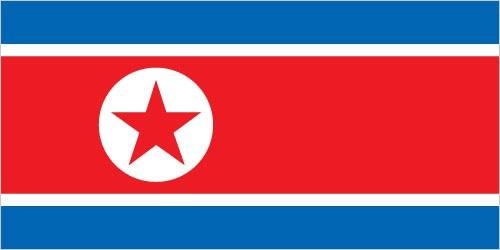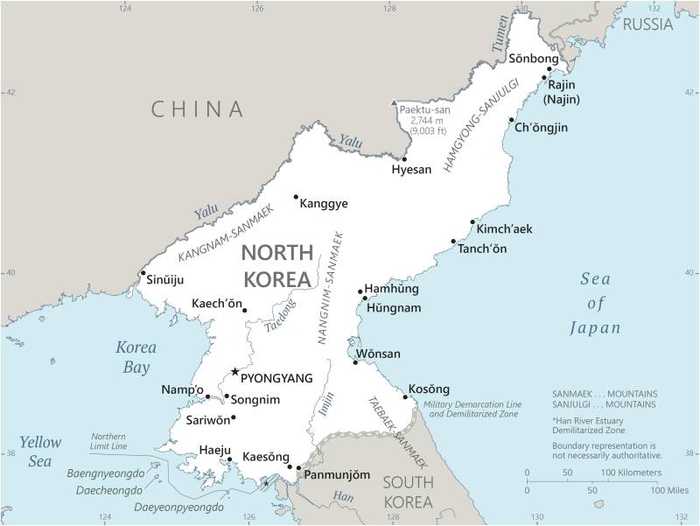157 North Korea

Three horizontal bands of blue (top), red (triple width), and blue. The red band is edged in white. On the hoist side of the red band is a white disk with a red five-pointed star. The broad red band symbolizes revolutionary traditions. The narrow white bands stand for purity, strength, and dignity. The blue bands signify sovereignty, peace, and friendship. The red star represents socialism.
Flag courtesy of the CIA World Factbook

Map courtesy of the CIA World Factbook

Statue of Chollima Movement in Pyongyang
Government
According to Britannica, the first constitution of the Democratic People’s Republic of Korea was promulgated in 1948 and was replaced with a new constitution in 1972. Revisions were made in 1992, 1998, 2009, and 2016. The 1998 amendments, made in the years following the death of Kim Il-Sung—the country’s leader from 1948 until his death in 1994—were so extensive that a preamble was added to underline the continuity with the previous regime. The preamble concludes, “The DPRK Socialist Constitution is a Kim Il-Sung constitution which legally embodies Comrade Kim Il-Sung’s Juche state construction ideology and achievements.” The 1998 revision also enshrined Kim as “eternal president.” The 2009 constitutional revision enshrined as the country’s highest administrative authority the supreme leader and chairman of the National Defense Commission (NDC). That position was held by Kim Jong Il, Kim Il-Sung’s son, until his death in 2011 and by Kim Jong Il’s successor, his son Kim Jong-Un. Subsequent revisions in 2016 created the State Affairs Commission, a new body that replaced the NDC as the highest government entity and represented an expansion of the powers given to Kim as its chairman.
The head of government is the premier, assisted by several vice-premiers and a cabinet, the members of which are appointed by the national legislature, the Supreme People’s Assembly (SPA). The president of the SPA is North Korea’s titular head of state. In practice, however, the government is under one-man leadership. During his lifetime, Kim Jong Il was also supreme commander of the Korean People’s Army and general secretary of the Korean Workers’ Party (KWP). After his death, Kim Jong-Un assumed those positions, and he was made chairman of the State Affairs Commission upon its creation.
The SPA, constitutionally the highest organ of state power and the primary legislative body, consists of a single chamber with 687 members elected to five-year terms by universal adult suffrage; it also has a 15-member SPA Presidium, or Standing Committee, with members chosen from within the SPA, that meets when the assembly is not in session. The SPA’s regular sessions last for about a week and are convened once or twice a year by the SPA Presidium. The Presidium handles most of the day-to-day legislative business and hence holds much power. The constitution stipulates that the SPA Presidium is the highest organ of power during the intervals between sessions of the SPA, although the Presidium remains accountable to the SPA.
Political power, as distinct from legislative power, is held by the Korean Workers’ Party (KWP), whose highest authority is the Party Congress, led by an elected Central Committee. The KWP draws up lists of approved candidates for elections. Policy is directed by the KWP’s political bureau (Politburo).
There are a number of nominal political parties and social organizations that serve to support the KWP. All political activities, however, are directed by the KWP or require its sanction and must closely follow the party line and policies. Elections provide a means whereby assent is registered for the policies and programs of the party. There is seldom more than one candidate on the ballot for each constituency, and the electoral system is completely controlled by the party.
North Korea is divided administratively into nine provinces (to), the special province-level municipality (jikhalsi) of P’yŏngyang, the special city (thŭkpyŏlsi) of Rasŏn, and two special administrative regions (chigu)—the Mount Kŭmgang tourist region and the Kaesŏng industrial region. The provinces are further subdivided into ordinary cities (si), counties (gun, or kun), and villages (ri), the smallest administrative unit. There are both provincial and city (or county) people’s committees and people’s assemblies. The people’s committees discharge administrative functions, and the people’s assemblies perform legislative functions. The provincial people’s assemblies approve the appointment of members of provincial people’s committees; the city (or county) people’s assemblies perform similar functions for local people’s committees. The people’s committees operate under the control of the cabinet (central government). The KWP also maintains central, provincial, and city (or county) party committees to “guide” other branches of government.
Provincial governments, presumably upon approval of the central government, can also designate “special cities” (t’ŭkgŭpsi) locally, as in the case of Namp’o. This port city, located about 30 miles (50 km) southwest of P’yŏngyang, is where North Korea receives foreign aid materials that arrive by sea.
The judicial system consists of the courts and the public prosecutor’s offices. Judicial authority rests with the Central Court, whose judges are elected for three-year terms by the Supreme People’s Assembly, and with a number of lesser provincial and people’s courts, whose members are elected by local people’s assemblies. Judges usually are party members or are controlled by the party. The Central Procurator’s Office and the provincial and city public prosecutor’s offices handle criminal cases and maintain surveillance over all citizens; it is headed by a procurator-general, who is selected by the Supreme People’s Assembly. The courts and prosecutor’s offices are independent of each other.
Civil / National Aviation Authority (CAA/NAA)
The North Korean civil aviation authority is known as the General Administration of Civil Aviation (GACA), and it is responsible for aviation regulation and safety within the country.
Airspace
SkyVector – Google Maps – ADS-B Exchange
ICAO countries publish an Aeronautical Information Publication (AIP). This document is divided into three parts: General (GEN), En Route (ENR) and Aerodromes (AD). ENR 1.4 details the types of airspace classes they chose to adopt from classes A through G.
None found by the author.
However, should you, the reader, happen to stumble across something to the contrary, please email the author at FISHE5CA@erau.edu and you may be mentioned in the ACKNOWLEDGEMENTS section of this book by way of thanks for contributing to this free eBook!
Drone Regulations
None found by the author.
However, should you, the reader, happen to stumble across something to the contrary, please email the author at FISHE5CA@erau.edu and you may be mentioned in the ACKNOWLEDGEMENTS section of this book by way of thanks for contributing to this free eBook!
Advanced Air Mobility (AAM) Regulations & Policies
None found by the author.
However, should you, the reader, happen to stumble across something to the contrary, please email the author at FISHE5CA@erau.edu and you may be mentioned in the ACKNOWLEDGEMENTS section of this book by way of thanks for contributing to this free eBook!
Advanced Air Mobility (AAM) News
None found by the author.
However, should you, the reader, happen to stumble across something to the contrary, please email the author at FISHE5CA@erau.edu and you may be mentioned in the ACKNOWLEDGEMENTS section of this book by way of thanks for contributing to this free eBook!
Short Essay Questions
Scenario-Based Question
You have been hired by a Drone Startup Company. Your boss has immediately assigned this job to you.
They need you to prepare a one-page memo detailing the legalities of using a drone to film in Pyongyang, pictured above.
They need you to mention any national laws and local ordinances.
They specifically want to know what airspace (insert pictures) you will be operating in and whether or not you need an airspace authorization.
Does it matter whether or not you are a citizen of the country?
Lastly, there is a bonus for you if, as you scroll through this chapter, you find any typos or broken links!
Short Essay Questions
- What are the drone categories?
- How is registration addressed?
- How is remote ID addressed?
- What are the model aircraft rules?
- What are the commercial drone rules?
- Are there waivers or exemptions to the rules? If so, for what?
- Would you share a link to an interactive airspace map?
- How is BVLOS addressed?
- How can you fly drones at night?
- How can you fly drones over people?
- Where do you find drone NOTAMs?
- What are the rules for drone maintenance?
- What are the rules for an SMS program?
- What are some unique rules not mentioned above?
- What are the C-UAS rules?
- What are the AAM rules?

